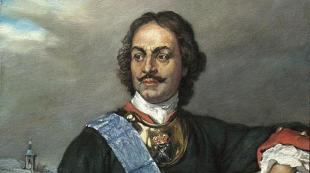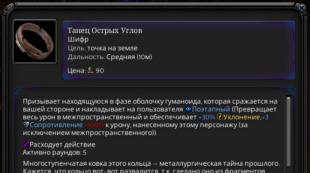Governing Senate in the first half of the 19th century. Features in the appointment of senators
Senate (in Russia) Senate in Russia, the Governing Senate, the highest governing body, which turned into the 19th century. to the supreme body of justice and supervision. Established by decree of Peter I on February 22, 1711. Initially, it functioned as a temporary collegial body to govern the country in the absence of the tsar, replacing Boyar Duma. It was a legislative body, a court of appeal. He also supervised colleges(except foreign). Initially consisted of 9 members and chief secretary. Members of the S. ‒ senators- were appointed by the king from among the civil and military officials of the first three classes (according to Tables of ranks). In 1722, the positions of procurator-general, requetmeister (receiving complaints and petitions against decisions and red tape of state institutions) and king of arms (accounting and managing the service of the nobility) were established, as well as offices: senate, revision, schismatic. S. in the absence of the king could make laws. From the 2nd quarter of the 18th century. the value of S. falls, it is limited Supreme Privy Council, then Cabinet of Ministers. In 1741, an attempt was made to restore the significance of S., but from 1756 it was again pushed aside by the Conference at the royal court. An attempt to raise the importance of S. (N. I. Panin’s project) led to S.’s reform (1763), according to which S. was divided into 6 departments: 4 in St. - judicial, 3rd - outskirts, communications, medical affairs and education, 4th - military administration; the Moscow departments corresponded to the 1st and 2nd St. Petersburg departments. From 1775, S.'s activity was limited to purely judicial functions. With the creation of ministries (1802), the S. became the highest body of court and supervision. By the middle of the 19th century. S. was a collection of 12 semi-independent departments, several general assemblies and other institutions, united only by the leadership of the prosecutor general, who became the minister of justice with the establishment of ministries. Each department consisted of several senators appointed for life by the tsar, headed by the chief prosecutor. As the court statutes were introduced in 1864, the appellate departments of S. began to close. In 1872, the Special Presence for the Judgment of State Crimes and Unlawful Communities, the highest political court of Russia, was created as part of the Council.
By the beginning of the 20th century The S. consisted of 6 departments (1st, 2nd, judicial, heraldry, 2 cassation), Special and Higher Disciplinary Presences, 3 general meetings and 5 combined presences of departments. In 1906, under S., the Supreme Criminal Court was established, which considered the crimes of mainly officials. After the fall of the autocracy in 1917, the Special Presence and the Supreme Criminal Court were abolished. The rest of S.'s apparatus remained unchanged. S. was abolished by a decree of the Soviets. authorities of November 22 (December 5), 1917.
Lit .: Eroshkin N. P., Essays on the history of state institutions of pre-revolutionary Russia, 2nd ed., M., 1968.
N. P. Eroshkin.
Great Soviet Encyclopedia. - M.: Soviet Encyclopedia. 1969-1978 .
See what "Senate (in Russia)" is in other dictionaries:
The ruling Senate in the Russian Empire is the highest state body subordinate to the Emperor. Established by Peter the Great on February 22 (March 5), 1711 as the highest body of state power and legislation. The building of the Senate and Synod in St. ... ... Wikipedia
I. The Senate in the reign of Peter Vel. Peter, during his constant absences, which often interfered with his current management affairs, repeatedly (in 1706, 1707, 1710) handed over the cases to several selected persons, from whom he demanded that they not ... ... Encyclopedic Dictionary F.A. Brockhaus and I.A. Efron
- (lat. Senatus from senex old man). Council of Elders; among the Romans, the highest deliberative assembly, in general the highest state institution, under whose jurisdiction is the judiciary. Dictionary of foreign words included in the Russian language. ... ... Dictionary of foreign words of the Russian language
Senate of the Russian Empire: history of creation and functions- March 5 (February 22 O.S.), 1711, by decree of Peter I, the Governing Senate was established as the highest body of state power and legislation, subordinate to the emperor. The need to create such an authority was due to the fact that ... ... Encyclopedia of newsmakers
Senate: The Senate is an advisory body, often the upper house, or one of the chambers of the legislative assembly (parliament) of any state: the Senate (Ancient Rome) (Latin senatus, from senex old man, council of elders) one of the highest ... ... Wikipedia
Senate of the Republic of Poland National Assembly of the Republic of Poland Upper House ... Wikipedia
The upper house of the Sejm of the Kingdom of Poland, and after the Commonwealth. The Senate was one of the three estates (along with the embassy hut and the king) that made up the Seim of the Commonwealth. Contents 1 Background ... Wikipedia
For the term "Senate", see other meanings. The Senate of the Parliament of the Republic of Kazakhstan is the upper chamber of the Parliament of the Republic of Kazakhstan. There are 47 seats in the Senate (in the future, their number may be increased by the former presidents of the Republic of Kazakhstan, ... ... Wikipedia
- (senate) Literally: old people's advice. Legislature in Ancient Rome. It is currently the upper house of legislatures in a number of countries, including the United States. The minimum age for a US Senator is 30 and for a member of the House of Representatives is 25. Political science. Dictionary.
- (Latin senatus), 1) in ancient Rome of the republican period, the supreme authority. 2) In Russia in 1711 1917 the Governing Senate is the highest body for legislation and public administration. From the 1st half of the 19th century. supreme judicial ... ... Modern Encyclopedia
Books
- Senators of the Russian Empire. In 2 volumes, Fedorchenko Valery Ivanovich. More than 300 years ago, in February 1711, the Governing Senate was approved in Russia. According to the idea of its creator, Peter the Great, it became the highest state body of the Russian…
- S. M. SOLOVIEV Selected works in 3 volumes (set), S. M. Solovyov. The three-volume collection of works of the great Russian historian S. M. Solovyov (1820-1879) offered to the attention of readers includes either those that were not republished after their first publication ...
With the advent of Alexander I to power, it was solemnly proclaimed that the basis of his policy would be strict observance of the laws. In the Manifesto issued on March 12, 1801, he announced that he would adhere to the political and legal course of Catherine II. In May 1801, an Unofficial Committee was created, which included representatives of the younger generation of the noble aristocracy, who adhered to liberal ideas and considered it necessary to reform the state structure of the Russian Empire.
The transformation of the Senate was provided for by the Decree of June 5, 1801, which instructed the members of the Senate to develop a draft law on its legal status. The main idea that all the developers should have laid at the heart of the reform of the Senate was to make the Senate a body that restrains the arbitrariness of the administration. Among the projects of the law on the Senate, special attention of Emperor Alexander I was attracted by the project of N.P. Rumyantsev, according to which the structure of the Senate had two main directions: it had to be an administrative or governmental body, carrying out supervisory and control activities over all government bodies in the empire, and at the same time, it had to be a judicial body, performing the function of "guardian of state laws". The content of this note was approved by Alexander I and some of its provisions were put into practice during the transformation of the Senate.
On September 8, 1802, the Decree “On the Rights and Obligations of the Senate” was issued, which handed over to the Senate both administrative and supervisory and judicial supervisory authorities. According to this decree, it was announced that 1) the Senate is the supreme place of the Empire, which, having subordinated all government offices, the repository of laws, seals on the universal observance of justice; therefore, the supreme audit in civil, criminal and boundary cases belongs to its impartial and unfeigned justice; 2) the power of the Senate is limited solely by the power of the Imperial Majesty, it has no other higher power over itself, 3) a single person of the Imperial Majesty presides in the Senate and 4) the decrees of the Senate are executed by everyone, as their own Imperial Majesty, one Sovereign or his Nominal Decree can stop Senate orders.
After defining the duties of the Senate, its internal composition was also changed. Upon the establishment of the Ministries, all ministers were declared members of the Senate, but since they were not always free from classes in their parts of government and therefore could not always be present at the General Assembly of the Senate, they were not allowed to sign protocols on those cases at the hearings of which they were not present. and on which they did not give their opinions in the Senate. The position of Minister of Justice must be inseparable from the position of Prosecutor General of the Senate. Governor-Generals for the affairs of the provinces entrusted to them were also appointed permanent members of both the General Assembly of the Senate and its Departments. In cases specified by law, outsiders could also be called to the presence of the Senate, but with only one advisory vote and for precisely those cases for which they were called.
The judicial significance of the Senate remained intact, its judicial departments were further developed. But the Senate, as a government institution, was not restored to its former rights. His competence in this range of affairs was, so to speak, made up of fragmentary assignments that do not constitute one harmonious and systematic whole.
In the first years of the reign of Emperor Alexander, the temporary Departments established by Emperor Paul were abolished: Treasury, Appeal and Boundary, which became unnecessary after they had completed the purpose for which they were established. In 1805, their number was increased by the addition of two new ones, along with this addition, a change was made in their name, so that the entire Senate in its final form consisted of the following 9 departments: in St. Petersburg - the first, the second appellate, the third appellate, fourth appellate (newly established), fifth criminal (previously 4th), boundary; in Moscow - the sixth criminal (formerly the fifth), the seventh appeal, the eighth appeal (newly established); of these, 4, 5 and Mezhevaya constituted a special temporary General Meeting instead of the abolished meeting of the three temporary Departments.
Each Department had its own special Chancellery under the direction of the Chief Prosecutor, appointed by the Minister of Justice. The office of each Department, branch and General Assembly was composed according to the state: chief secretaries, secretaries, executors, recorders, registrars, assistants or clerks with their assistants and the required number of clerical servants. In some departments, where it was needed, there could be "translators of special languages." The head of the Chancellery of the Senate in its general composition was the Minister of Justice or the Prosecutor General.
At the end of 1808, Alexander I instructed M.M. Speransky, the development of a plan for the state transformation of Russia. In October 1809, a draft entitled "Introduction to the code of state laws" was submitted to the king.
But these transformations did not significantly affect the Senate, although Speransky intended to make fundamental changes in this body. By the beginning of 1811, a draft reform of the Senate was being prepared, and in June it would be submitted for consideration to the State Council. Speransky mainly wanted to separate the administrative and judicial parts in the Senate and proposed to transform the Senate into two institutions. The Governing Senate concentrated government affairs and a committee of ministers - ministers with their comrades and heads of special (main) parts of the administration. The Judicial Senate was divided into four local branches in accordance with the main judicial districts of the empire: in St. Petersburg, Moscow, Kiev and Kazan. The State Council sharply criticized this project, but the majority voted in favor. However, Speransky himself advised not to take it.
In the second half of the reign of Alexander I, no significant changes were made in the Senate either, so that he largely remained unreconciled with other institutions.
To strengthen and streamline state power, Nicholas I ordered the codification of laws. By 1833, 15 volumes of the new Code of Laws of the Russian Empire were prepared, approved and approved by the State Council and the Tsar and put into effect on January 1, 1835. Nicholas I gave preference to the drafting of new legislation on the rights of estates. But, fearing new manifestations of discontent on the part of the noble society, and also as a result of the Polish uprising of 1830-1831, the tsar refused to carry out fundamental reforms in the state and social system.
Nikolai Pavlovich finally issued decrees determining the composition of the Senate and the competence of its affairs. Now the Senate consisted of 11 departments: the 1st, 2nd, 3rd, 4th, 5th and Mezheva were in St. Petersburg, the 6th, 7th, and 8th in Moscow; 9th and 10th in Warsaw. In each department of the Senate, excluding the first, and in each department of the department, the Imperial Majesty annually appoints the first present. The first department of the Senate should combine all matters related to administration in the Empire, and the 5th in St. Petersburg, the 6th in Moscow and the 10th in Warsaw departments were in charge of criminal cases, the rest - judicial. Of the cases exclusively subject to the jurisdiction of the Senate, he was given a trial of the provincial marshals of the nobility for crimes of office.
The code of laws assigned to the Senate as its main function - the implementation of supervisory and control activities over government bodies and the forms of this activity.
The Senate, while remaining an administrative institution, became the supreme court of the empire.
In the era of Peter the Great, the Governing Senate appeared in Russia. Over the next two centuries, this state authority was reformatted many times according to the will of the next monarch.
Emergence of the Senate
The ruling senate was created by Peter I as a "safety cushion" in case the sovereign left the capital. The tsar was known for his active character - he was constantly on the road, because of which the state machine could stand idle for months in his absence. These were the visible costs of absolutism. Peter really was the only embodiment of state power in the vastness of the empire.
The initial Governing Senate (1711) included the closest associates and assistants of the king, who had his many years of trust. Among them are Pyotr Golitsyn, Mikhail Dolgorukov, Grigory Volkonsky and other high-ranking nobles.
The creation of the Governing Senate under Peter 1 took place in an era when there was no clear separation of powers in Russia (judicial, executive and legislative). Therefore, the terms of reference of this body constantly changed depending on the situation and expediency.
In his first instruction, Peter announced to the senators that they should pay special attention to the state of the treasury, trade and courts. The important thing is that this institution has never been in opposition to the king. In this, the Russian Senate was the exact opposite of the body of the same name in neighboring Poland or Sweden. There, a similar institution represented the interests of the aristocracy, which could oppose the policies of their monarch.
Interaction with the provinces
From the very beginning of its existence, the Governing Senate worked a lot with the regions. Huge Russia has always needed an effective system of interaction between the provinces and the capital. Under Peter's successors, there was a complex network of orders. In connection with large-scale reforms in all spheres of the country's life, they have ceased to be effective.
It was Peter who created the provinces. Each such administrative entity received two commissioners. These officials worked directly with the Senate and expressed the interests of the province in St. Petersburg. With the help of the reform described above, the emperor expanded the scope of self-government in the provinces.

Fiscals and prosecutors
Of course, the creation of the Governing Senate could not do without the establishment of new posts related to its work. Fiscals appeared along with the new body. These officials were the king's overseers. They controlled the work of institutions and ensured that all the instructions of the monarch were carried out exactly to the last remark.
The existence of fiscals led to abuses. A person with such power could use his position for selfish purposes. At first, there was not even a regulated punishment for false denunciation. In connection with the ambiguous service of fiscals in Russian, this word received a second negative lexical meaning of informer and sneak.
Nevertheless, the creation of this post was a necessary measure. The chief fiscal (chief fiscal) could demand an explanation from any official in the Senate. Thanks to this state of affairs, every nobleman, no matter how high his position, knew that his own abuses of power could ruin him. Fiscals existed not only in St. Petersburg, but also in the provinces (provincial-fiscals).
Very quickly, the creation of the Governing Senate showed that this state body cannot work effectively due to internal strife between senators. Often they could not come to a common opinion, they went over to personalities in their disputes, etc. This interfered with the work of the entire apparatus. Then Peter in 1722 established the position of Prosecutor General, who became the main person in the Senate. He was a "bridge" between the sovereign and the metropolitan institution.

In the era of palace coups
After the death of the autocrat, the functions of the Governing Senate were seriously curtailed for the first time. This happened due to the fact that it was established in which favorite aristocrats sat and He became an alternative to the Senate and gradually took over his powers.
After her accession to the throne, she restored the old order. The Senate again became the main judicial institution of the empire; the military and naval collegiums were subordinate to it.

Reforms of Catherine II
So, we figured out what functions the Governing Senate performed. It should be noted that Catherine II did not like this position. The new empress decided to reform. The institution was divided into six departments, each of which was responsible for a specific area of the life of the state. This measure helped to more accurately outline the powers of the Senate.
The first department dealt with internal political affairs, the second - judicial. The third - provinces that had a special status (Estland, Livonia, and Little Russia), the fourth - military and maritime issues. These institutions were located in St. Petersburg. The two remaining Moscow departments were in charge of court and administrative affairs. These are the functions that the Governing Senate was endowed with under Catherine II.
The Empress also significantly increased the influence of the Prosecutor General on the work of all departments. Over time, this position has lost its former importance. Catherine preferred to keep everything under control and thus restored the Petrine order of autocracy.
During the short reign of her son Paul, the Senate again lost most of its rights. The new emperor was extremely suspicious. He did not trust the nobles, who had at least some influence and tried to contribute to the making of state decisions.

In the 19th century
As it was at the very end of its existence (on the eve of the revolution), the Governing Senate was created during the reign of Alexander I. It was then that the political system of the empire stabilized. They stopped and the inheritance of the royal title ceased to be a lottery.
Alexander was probably the most democratically minded Russian emperor. He got into his hands the state, which worked on outdated mechanisms that urgently needed to be changed. The new king understood that the creation of the Governing Senate (year 1711) was dictated by good goals, but believed that over the years this body had lost its significance and turned into a pathetic imitation of itself.
Immediately after his appearance on the throne, Alexander I in 1801 issued a decree in which he invited the officials who worked in this institution to submit their projects for the upcoming reform to him for consideration. For several months, active work was underway to discuss the reformatting of the Senate. Members of the Unspoken Committee took part in the discussion - young aristocrats, friends and associates of Alexander in his liberal undertakings.

Progress
Senators were appointed to their office personally by the emperor. They could only be officials of the first three classes (according to the Table of Ranks). Theoretically, a senator could combine his main position with some other. For example, this amendment was often used in the case of the military.
Direct decisions on a particular issue were made within the walls of a particular department. At the same time, general meetings were periodically convened, which were attended by all members of the Senate. The decree adopted in this state body could only be canceled by the emperor.
Functions
Let's remember in what year the Governing Senate was created. That's right, in 1711, and since then this institution of power has regularly participated in legislation. In the course of his reforms, Alexander I created a special institution for this purpose - the State Council. However, the Senate was still able to develop draft laws and submit them for higher consideration through the Minister of Justice, who from the 19th century also combined the old position of Attorney General with the new one.
At the same time, ministries were created in place of the collegiums. At first, there was some confusion in the relationship between the new executive bodies and the Senate. The powers of all departments were finally defined by the end of the reign of Alexander I.
One of the most important functions of the Senate was its work with the treasury. It was the departments that verified the budget, and also reported to the supreme authority about arrears and lack of money. In addition, the Senate was put above the ministries in resolving interdepartmental property disputes. This state body regulated internal trade, appointed justices of the peace. The senators kept the coat of arms of the empire (a special department was even created for this).

Significance of the Senate and its abolition
Peter I needed a state institution that could replace him during his absence from the capital. The creation of the Governing Senate helped the emperor in this. The date of the appearance of the post of Prosecutor General (1722) is also considered the birthday of the Prosecutor's Office in modern Russia.
However, over time, the functions of the Senate have changed. The executive power of officials was not great, but they remained an important layer between numerous boards (and later ministries).
The Senate played a significant role in judicial matters. Appeals poured in from all over the country. Dissatisfied provincial prosecutors, as well as governors, wrote to the Senate. This order was established after Alexander II in the 1860s.
When the Bolsheviks came to power in Russia, one of their first laws banned the activities of the Senate. It was Decree No. 1 on Court, adopted on December 5, 1917.
History of Russia in the 18th-19th centuries Milov Leonid Vasilyevich
§ 2. Senate and colleges
§ 2. Senate and colleges
The famous Senate was "born" by Peter I, as if impromptu. Departing for the Prut campaign in February 1711, Peter issued a decree: “The ruling Senate was determined to be for our absences, to manage ...” Its composition was small (9 senators), and it was created, sort of, temporarily. In pursuit of the first decree, on March 2, a second one came with a list of powers (care of justice, the organization of state revenues, general administration, trade and economy). Soon the Senate became the highest judicial and administrative body. At first, the Senate was a collegiate body of 9 senators with equal votes. Communication between the Senate and the provinces was carried out by provincial commissars.
Almost simultaneously with the Senate, Peter I founded a new control and revision institute of the so-called fiscals. It was a whole army of officials acting in secret and revealing all unrighteous actions that were detrimental to the state (embezzlement, bribery, violation of the law, etc.). At the head of all fiscals was the chief fiscal at the Senate. He had 4 fiscals subordinate to him (two from the merchants and two from the nobility). Under provincial governments there were also 4 fiscals, in cities - one or two fiscals. Fiscals did not receive a salary, as a reward for their work they were entitled in the first years to half, and then a third of the confiscated property.
Fiscals sent all their observations to the Punishment Chamber, from where cases were sent to the Senate. Since 1715, the Senate itself was overseen by a special Senate Auditor General, and since 1721, control was carried out monthly by the staff officers of the guard.
Gradually, such a form of government as a collegium made its way. Back in 1711, the mining officer Johann Blier submitted a project to organize a special board to manage the mining industry. The following year, projects for the organization of the Commerce Collegium and the Revision Collegium appeared, and in 1715 the Commerce Collegium began to function. At the same time, in 1715, the study of the issue of organizing central government bodies and the study of the experience of Denmark, Sweden and Austria began. The three most important colleges (Military, Admiralty and Foreign) began to work already in 1718. A total of 11 colleges were established (the remaining eight: the Berg College, the Manufactory College, the College of Commerce, the College of Chambers, the State Offices College, the Votchinnaya Board, Revision Board and Justice Board). The structure and functions of the collegiums, up to the organization of office work, the procedures for meetings, were developed in detail in the General Regulations and the regulations of individual collegiums. Thus was laid the foundation for the unification and bureaucratization of public administration.
Among the central institutions was to belong to the Synod, or the Spiritual College. At one time, on the advice of Alexei Kurbatov, one of the first dodgy tsarist "profit-makers", after the death of Patriarch Adrian, the tsar appointed only an acting (locum tenens) to this post, and did not hold elections for the patriarch. The reason for this was the restrained, if not hostile, attitude of the clergy to the transformations of the king, the involvement of the clergy in the case of Tsarevich Alexei. As a result, in 1721, a Synod was formed, headed by the president, the former locum tenens Stefan Yavorsky. Since S. Yavorsky was already at a very advanced age, the actual head of the Synod was the Vice-President Archbishop of Pskov Feofan Prokopovich. It was he who composed the Spiritual Regulations - a set of the most important organizational and ideological regulations that formed the basis for the activities of the entire church organization in the new conditions of absolutism. According to the Rules, the members of the Synod, like all officials, swore allegiance to the tsar and pledged "not to enter into worldly affairs and rituals for anything." Behind all this stood the unforgotten danger of the pride of Patriarch Nikon. The same motives dictated the principles of collegiate management of the church and made it obligatory for priests to violate the secrecy of confession in cases "threatening state interests." Outwardly, all this, according to the stories, looked rather intimidating. As N. I. Pavlenko writes, the tsar, at a meeting with the hierarchs of the church, realizing that they want to elect a patriarch, raised the Spiritual Regulations in his hand and declared: “You are asking for a patriarch, here is a spiritual patriarch for you!” And to the murmur of the dissatisfied, he uncovered a dagger and with the words: “And for those who think differently, here is the damask patriarch,” he hit them on the table.
In 1718–1722 The Senate was reformed. In particular, all presidents of the collegiums became its members. The position of Prosecutor General was introduced. With his appearance, a whole army of prosecutors began to operate in all central and provincial institutions. All the fiscals of the empire were subordinate to him. The Prosecutor General and Chief Prosecutor of the Senate were subordinate only to the sovereign. All cases received by the Senate passed through the hands of the Prosecutor General. He could appeal and suspend the decision of the Senate. The main function of the prosecutor's control is to ensure the observance of law and order. The first prosecutor general was Pavel Ivanovich Yaguzhinsky.
In 1721, the Main Magistrate was recreated in St. Petersburg as a central institution, and city magistrates were newly formed in the localities, to some extent reflecting the class interests of the merchants. Finally, in addition to the Preobrazhensky Prikaz, the Secret Chancellery was established to deal with cases of political investigation in St. Petersburg.
March 5, 2011 marks the 300th anniversary of the establishment of the Senate - the highest body of state power and legislation of the Russian Empire.
On March 5 (February 22 old style), 1711, by decree of Peter I, the Governing Senate was established - the highest body of state power and legislation, subordinate to the emperor.
The need to create such a body of power was due to the fact that Peter I often left the country and therefore could not fully deal with the current affairs of government. During his absence, he entrusted the conduct of business to several trusted persons. On March 5 (February 22), 1711, these powers were assigned to the Governing Senate. Initially, it consisted of 9 members and a chief secretary and acted exclusively on behalf of the king and reported only to him.
After the Table of Ranks was adopted (the law on the order of public service in the Russian Empire, which regulates the ratio of ranks by seniority and the sequence of promotion to ranks), members of the Senate were appointed by the tsar from among civil and military officials of the first three classes.
In the early years of its existence, the Senate dealt with state revenues and expenditures, was in charge of the attendance of the nobles for service, and was an oversight body for the bureaucratic apparatus. Soon, fiscal positions were introduced in the center and in the regions, who reported on all violations of laws, bribery, embezzlement and other similar actions. After the creation of collegiums (central bodies of sectoral management), all the heads of collegiums entered the Senate, but this order did not last long, and subsequently the heads of collegiums were not included in the Senate. The Senate oversaw all colleges, except for the foreign one. The post of Prosecutor General was introduced, which controlled all the work of the Senate, its apparatus, the office, the adoption and execution of all its sentences, their appeal or suspension. The Prosecutor General and the Chief Prosecutor of the Senate were subordinate only to the sovereign. The main function of the prosecutor's control was to ensure the observance of law and order.
From 1711 to 1714 the seat of the Senate was Moscow, but sometimes for a while, as a whole or in the person of several senators, he moved to St. Petersburg, which from 1714 became his permanent seat. Since then, the Senate has moved to Moscow only temporarily, in the case of Peter's trips there for a long time. A part of the Senate office remained in Moscow.
In April 1714, a ban was issued to bring complaints to the tsar about the unfair decisions of the Senate, which was an innovation for Russia. Until that time, the sovereign could complain about every institution. This prohibition was repeated in a decree on December 22, 1718, and the death penalty was established for filing a complaint against the Senate.
After the death of Peter I, the position of the Senate, its role and functions in the system of state administration gradually changed. Other supreme state bodies were created, to which the functions of the Senate were transferred. Under Catherine II, the Senate was removed from the main legislative functions of political significance. Formally, the Senate was the highest court, but its activities were greatly influenced by the decisions of the Prosecutor General and the admission of complaints against him (despite the formal ban). Catherine II preferred to entrust the functions of the Senate to her proxies.
In 1802, Alexander I issued a decree on the rights and obligations of the Senate, which, however, had almost no effect on the real state of affairs. The Senate had the formal right to develop bills and subsequently submit them to the emperor, but he did not use this right in practice. After the establishment in the same year of the ministries, the Senate retained the functions of the highest judicial body and supervisory authority, since the main managerial functions remained with the Committee of Ministers (which became the highest executive body).
In 1872, the "Special Presence for the Judgment of State Crimes and Unlawful Communities" was created as part of the Senate - the highest political court in Russia.
By the beginning of the XX century. The Senate finally lost its significance as the highest body of state administration and turned into a body of supervision over the legality of the actions of government officials and institutions and the highest cassation instance in court cases. In 1906, the Supreme Criminal Court was established, which considered the crimes of mainly officials.
In 1917, the Special Presence and the Supreme Criminal Court were abolished.
The Senate was abolished by a decree of the Soviet government of December 5 (November 22), 1917.
The material was prepared on the basis of information from open sources









